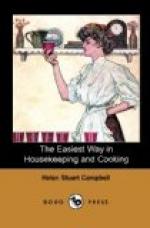To finish as wheat bread, stir in enough flour from the two quarts remaining to make a dough. Flour the molding-board very thickly, and turn out. Now begin kneading, flouring the hands, but after the dough is gathered into a smooth lump, using as little flour as may be. Knead with the palm of the hand as much as possible. The dough quickly becomes a flat cake. Fold it over, and keep on, kneading not less than twenty minutes; half an hour being better.
Make into loaves; put into the pans; set them in a warm place, and let them rise from thirty to forty-five minutes, or till they have become nearly double in size. Bake in an oven hot enough to brown a teaspoonful of flour in one minute; spreading the flour on a bit of broken plate, that it may have an even heat. Loaves of this size will bake in from forty-five to sixty minutes. Then take them from the pans; wrap in thick cloths kept for the purpose and stand them, tilted up against the pans till cold. Never lay hot bread on a pine table, as it will sweat, and absorb the pitchy odor and taste; but tilt, so that air may pass around it freely. Keep well covered in a tin box or large stone pot, which should be wiped out every day or two, and scalded and dried thoroughly now and then. Pans for wheat bread should be greased very lightly; for graham or rye, much more, as the dough sticks and clings.
Instead of mixing a sponge, all the flour may be molded in and kneaded at once, and the dough set to rise in the same way. When light, turn out. Use as little flour as possible, and knead for fifteen minutes; less time being required, as part of the kneading has already been done.
GRAHAM BREAD.
One quart of wheat sponge; one even quart of graham flour; half a teacupful of brown sugar or molasses; half a teaspoonful of soda dissolved in a little hot water; and half a teaspoonful of salt.
Pour the sponge in a deep bowl; stir in the molasses, &c, and lastly the flour, which must never be sifted. The mixture should be so stiff, that the spoon moves with difficulty. Bake in two loaves for an hour or an hour and a quarter, graham requiring longer baking than wheat.
If no sponge can be spared, make as follows: One pint of milk or water; half a cup of sugar or molasses; half a cup of yeast; one teaspoonful of salt; one cup of wheat flour; two cups of graham. Warm the milk or water; add the yeast and other ingredients, and then the flour; and set in a cool place—about 60 deg. Fahrenheit—over-night, graham bread souring more easily than wheat. Early in the morning stir well; put into two deep, well-greased pans; let it rise an hour in a warm place, and bake one hour.
GRAHAM MUFFINS.
These are made by the same rule as the bread. Fill the muffin-pans two-thirds full; let them rise till even with the top of the pans, which will take about an hour; and bake in a quick oven twenty minutes. To make them a little nicer, a large spoonful of melted butter may be added, and two beaten eggs. This will require longer to rise, as butter clogs the air-cells, and makes the working of the yeast slower. The quantities given for bread will make two dozen muffins.




